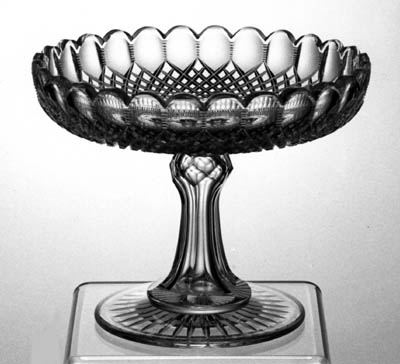
The two late "middle period" compotes that are discussed in this file were discovered by the writer several years ago. They are remarkably similar to those that were in use at the White House during the presidency of Rutherford B. Hayes. Spillman (1989, p. 87), who has provided a comprehensive account of glassware at the White House, includes a photograph of a table setting used for a luncheon hosted by Mrs. Hayes in 1881. On the table are "at least six" such compotes, but today only one remains. It is reproduced here from a photograph in Spillman's book, p. 88. (This photograph is by Nicholas Williams, Corning Museum of Glass, NY. The image is copyrighted and is reproduced by permission of WHC/WHHA). Spillman suggests that this survivor was "probably ordered by Mrs. Grant or by Mrs. Hayes in the 1870s" (Spillman 1989, p. 88). However, it and its companions are not found on any existing invoice (note 1).

The two compotes formerly owned by the writer are pictured below. In general, they match the style of the White House's compote. All three compotes have waisted stems that contain air traps. On the example from the White House there is a swelling, or knop, directly beneath the bowl. and a cut pattern of broken, or offset, flutes, on the compote's stem has been extended to cover the knop. While the other two compotes also have knops beneath their bowls, they are faceted and the compotes' stems are flute-cut (paneled). Note that the White House compote has a prominent wafer between its stem and its foot. The other compotes have none.
The cut patterns on the bowls of all three compotes are sometimes simply referred to as "diamond-cut", even though they differ from one another. The diamond cutting on the bowl of the White House compote "comes so near the scalloped rim ... that the piece may have been cut down from a slightly taller original .." (Spillman 1989, p. 88). Perhaps, but also perhaps not. The first of the other compotes has a similar rim and cutting, and there is no evidence that it was ever repaired.
The pattern on the second compote has been seen on many pieces of antique tableware over the years. Although the pattern has not yet been identified, it must have been a popular one in its day, cut by more than one company, judging by how frequently it is found (See the Dorflinger 6 file in Part 2 for additional examples).
The sizes of the following two compotes, c1875, are identical: H = 6.5" (16.5 cm), D = 8.25" (21.0 cm). The first compote weighs 3 lb (1.4 kg); the second one 3.5 lb (1.6 kg), in spite of a thinner foot. They were purchased six months apart, in late 1984 and early 1985, at a large antiques show in Woburn, MA. Each sold for $250 in 1988.


A compote similar to the ones in this file is illustrated in C. Dorflinger & Sons' earliest extant catalog (ACGA reprint of c1888 catalog, p. 80). No dimensions are given. Only one other authentic Dorflinger "high compote" (to use Dorflinger's term) is known in the literature. Feller (1989) shows it on p. 28 and dates it c1890. Again, no dimensions are given. These two compotes might have been larger than the compotes discussed here. Their knops are treated more emphatically and are either faceted or cut with three rows of cross-cut diamonds. This might be considered to be a slight "design shift" during the dozen-plus years between the assumed date of the White House compote (and the compotes shown here), c1875, and the illustrationed examples in the Dorflinger catalog and in Feller's book. Mysteriously, the compote shown by Feller has disappeared without a trace!
The writer does not wish to over-emphasize the possibility of a Dorflinger origin for the compotes in this file. But it is a definite possibility. Nevertheless, the form was a popular one and similar items were undoubtedly produced by other glasshouses.
NOTE:
1. The photograph of Mrs. Rutherford's table also shows two compotes that are larger than those in this file. Spillman states that they were "originally ordered" in 1829, during the administration of Andrew Jackson. She also provides a close-up photograph of one of them (Spillman 1988, p. 32). Palmer, on the other hand, questions this date, believing that these larger compotes belong to a later period. She provides a somewhat different view of the chronololgy of cut glass made during these early years of the "middle period" than what is found in Spillman's book (Palmer, Arlene, 1990: Book review of WHITE HOUSE GLASSWARE by Jane Shadel Spillman, The Glass Club Bulletin, No. 160, pp. 8-9.).
Three examples of the Jacksonian tableware -- that do not include the compotes -- are also illustrated in a comprehensive study of White House furnishings by Monkman who agrees with Spillman's dating for the Jacksonian tableware, stating that it is "the oldest extant glass service in the White House" (Monkman 2000, p. 80). She also provides a photograph of the famous President Madison decanter of 1816 (p. 47), as does Spillman (1989, p. 16).
Reference: [Havens, J. M.], 1988: Some Dorflinger attributions, The Hobstar, Vol. 10, No. 7, pp. 13-15 (Apr).
Updated 5 Aug 2007